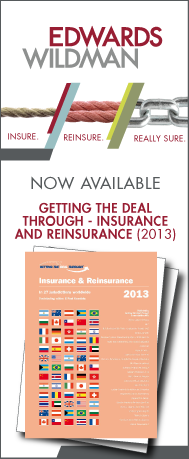 |
|
| edwardswildman.com | |
World Trade Center: One Event or Two? by David Kendall (London) In many areas of business insurance and reinsurance, whether a series of claims or losses is treated as one claim or several claims for the purposes of the insurance or reinsurance contract is an important question. It has repercussions on how many deductibles or excesses apply, the applicable limits of cover, and the effect of giving notice of claims. Under English law, the treatment of serial claims or losses under an insurance or reinsurance contract depends on the terms of the contract. Some contracts provide for broad aggregation, some for narrow, and some for none. Generally, one is looking for a “unifying” factor which provides for the aggregation of individual claims or losses as one claim for the purposes of the contract. As noted by Lord Mustill in the key case of AXA Re v Field1, it will depend on the particular circumstances of each case whether the aggregation of serial claims and their treatment as one claim under the policy is in the best interest of the policyholder, or the insurer, or the reinsurer. Aggregation of claims or losses does not always favour the insured or reinsured. AXA Re v Field concerned the negligent underwriting by Lloyd’s underwriters of LMX spiral risks. Members’ Agents were sued by the syndicate members for losses caused by the negligent underwriting. The agents had errors and omissions insurance which provided for one deductible for any series of occurrences “arising from one originating cause”. It was held in Cox v Bankside Members Agency Limited2 that the cause of the underwriting losses was each underwriter’s failure to track exposures and that accordingly there was one claim, and one deductible, in respect of all the claims for all the losses suffered as a result of each individual underwriter’s negligence. The agents’ E&O insurers had excess of loss treaty reinsurance underwritten in part by AXA Re with limits of $1 million xs $1 million for each and every loss. “Each and every loss” was defined to include a series of losses arising out of one event. The E&O insurers argued that this provided for the same basis of aggregation as the “arising from one originating cause” language in the E&O insurance. The House of Lords (and particularly Lord Mustill) disagreed. Lord Mustill said that “…an event is something which happens at a particular time, at a particular place, in a particular way”. This reflects the so-called “unities” doctrine which first appeared in Michael Kerr QC’s Award in the Dawson’s Field arbitration. For several losses to arise out of one event, there must be a degree of unity in relation to the cause, locality and time of the incidents said to constitute one event (and the circumstances and purposes of persons responsible for the incidents if relevant). Lord Mustill went on to say that “A cause is…something altogether less constricted. It can be a continuing state of affairs; it can be the absence of something happening.” Although the losses caused by the negligent underwriting of the Lloyd’s underwriter may have arisen from one originating cause, each act of underwriting was a separate event, and accordingly the losses caused by the underwriting of separate contracts by the underwriter could not be aggregated and each loss would be subject to the excess of $1 million. A recent case illustrates the importance of the distinction between an event and a cause in this area. Aioi Nissay Dowa v Heraldglen3 concerned a dispute between a retrocedant (Aioi) and its retrocessionaires over cover for the World Trade Center (WTC) catastrophe. In the morning of 11 September 2001, a hi-jacked American Airlines plane crashed into the North Tower of the WTC, to be followed shortly thereafter by a hi-jacked United Airlines plane crashing into the South Tower. Aioi paid claims on its inwards reinsurances in respect of the liabilities of the airlines and airport security companies for the significant losses resulting from the destruction of the North and South Towers. Aioi claimed on its retrocessions on the basis that the claims arose out of one event and thus constituted one loss. The retrocessionaires said that there were two events. The dispute was heard by a London arbitration tribunal and it found in favour of the retrocessionaires. Aioi appealed against the Award on the ground that the Tribunal had made an error of law in reaching its conclusion that the insured losses caused by the attacks on the WTC arose out of two events and not one. Mr Justice Field held that the Tribunal had accurately identified the applicable law pursuant to which it undertook an exercise of judgment and that in making its decision, it had correctly applied the law, had regard to all material matters, and did not take into account impermissible considerations. The Award accordingly stood and the appeal was dismissed. In particular, the judge found that the Tribunal was correct in finding that the conspiracy or plan underlying the hi-jackings was not an “event” for the purposes of the retrocessions, and that there was no sufficient unity of time or location for the losses to have arisen out of one event, notwithstanding that the North and South Towers were part of an overall complex and notwithstanding the relative closeness in time between the commencement of each flight and the subsequent crashes. As regards location, the Towers were separate buildings and they did not stand or fall together. As for the time factor, the Tribunal was entitled to take into account the whole period of time from the check-in of the hi-jackers at Boston Airport to the collapse of each of the Towers because the losses in question were the liabilities of the airlines and the security companies in respect of the hi-jacks. The hi-jackings of the two aircraft were independent of each other in time and location. The Aioi case is a further illustration of the application of the “unities” doctrine in analysing whether or not a series of losses arise out of one event. The analysis is inevitably driven by the particular circumstances of the losses although the principles that are applied are now relatively clear.
ENDNOTES
1 [1996] 2 Lloyd’s Law Reports 233 2 [1995] 2 Lloyd’s Law Reports 437 3 [2013] EWHC 154 (Comm) – Judgment of Mr Justice Field Contact
| |
 |
|

